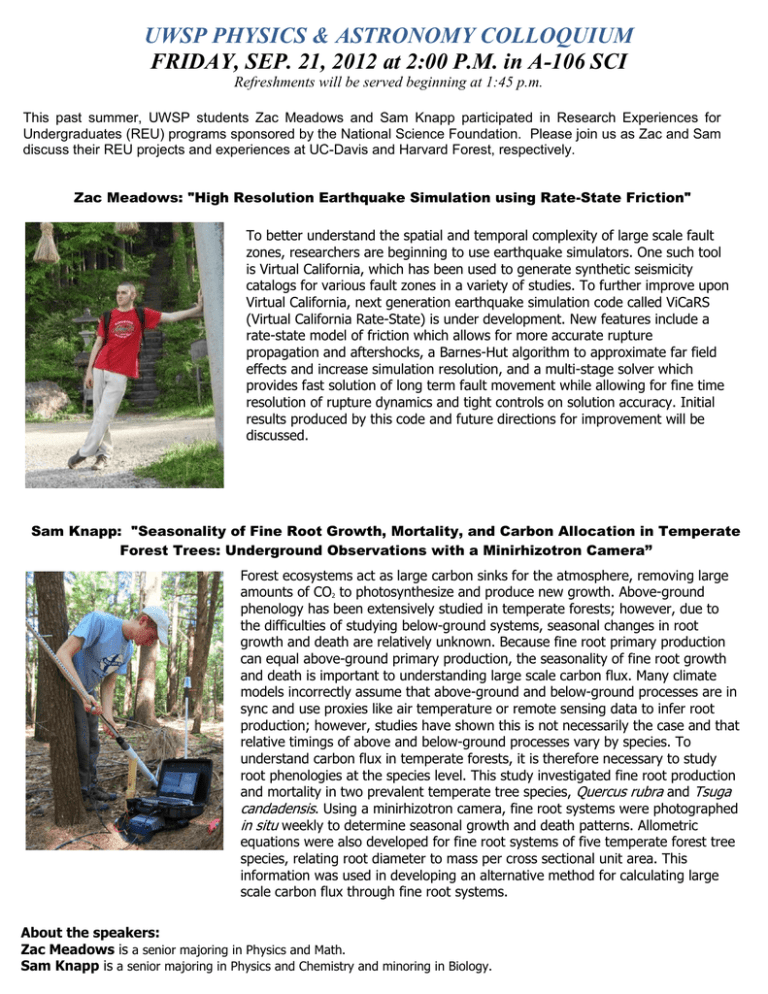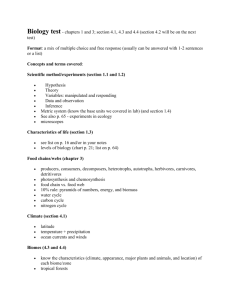Document 11805285
advertisement

UWSP PHYSICS & ASTRONOMY COLLOQUIUM FRIDAY, SEP. 21, 2012 at 2:00 P.M. in A-106 SCI Refreshments will be served beginning at 1:45 p.m. This past summer, UWSP students Zac Meadows and Sam Knapp participated in Research Experiences for Undergraduates (REU) programs sponsored by the National Science Foundation. Please join us as Zac and Sam discuss their REU projects and experiences at UC-Davis and Harvard Forest, respectively. Zac Meadows: "High Resolution Earthquake Simulation using Rate-State Friction" To better understand the spatial and temporal complexity of large scale fault zones, researchers are beginning to use earthquake simulators. One such tool is Virtual California, which has been used to generate synthetic seismicity catalogs for various fault zones in a variety of studies. To further improve upon Virtual California, next generation earthquake simulation code called ViCaRS (Virtual California Rate-State) is under development. New features include a rate-state model of friction which allows for more accurate rupture propagation and aftershocks, a Barnes-Hut algorithm to approximate far field effects and increase simulation resolution, and a multi-stage solver which provides fast solution of long term fault movement while allowing for fine time resolution of rupture dynamics and tight controls on solution accuracy. Initial results produced by this code and future directions for improvement will be discussed. Sam Knapp: "Seasonality of Fine Root Growth, Mortality, and Carbon Allocation in Temperate Forest Trees: Underground Observations with a Minirhizotron Camera” Forest ecosystems act as large carbon sinks for the atmosphere, removing large amounts of CO2 to photosynthesize and produce new growth. Above-ground phenology has been extensively studied in temperate forests; however, due to the difficulties of studying below-ground systems, seasonal changes in root growth and death are relatively unknown. Because fine root primary production can equal above-ground primary production, the seasonality of fine root growth and death is important to understanding large scale carbon flux. Many climate models incorrectly assume that above-ground and below-ground processes are in sync and use proxies like air temperature or remote sensing data to infer root production; however, studies have shown this is not necessarily the case and that relative timings of above and below-ground processes vary by species. To understand carbon flux in temperate forests, it is therefore necessary to study root phenologies at the species level. This study investigated fine root production and mortality in two prevalent temperate tree species, Quercus rubra and Tsuga candadensis. Using a minirhizotron camera, fine root systems were photographed in situ weekly to determine seasonal growth and death patterns. Allometric equations were also developed for fine root systems of five temperate forest tree species, relating root diameter to mass per cross sectional unit area. This information was used in developing an alternative method for calculating large scale carbon flux through fine root systems. About the speakers: Zac Meadows is a senior majoring in Physics and Math. Sam Knapp is a senior majoring in Physics and Chemistry and minoring in Biology.




